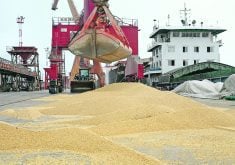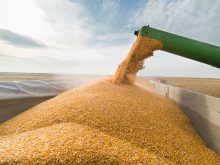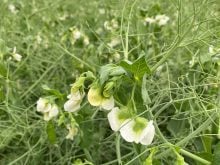With prices for some classes at an all-time high, market analysts say it is time to unload small-seeded chickpeas.
Last week’s desi prices were around 21-22 cents per pound delivered to processing plants in Saskatchewan, the highest level since 1999 when data collecting began. Prices for small kabulis and B-90s were 27 cents per lb.
“Given where we’re at historically, I would sell it and let her go,” said Greg Kostal, pulse crop analyst with Kostal Ag Consulting.
“These types of high prices are not sustainable.”
Read Also

Bunge’s crop mix is changing
Bunge has predominantly been a soybean processing firm, but that’s about to change after the merger with Viterra with softseed processing and grain merchandising gaining ground.
Other analysts like CGF Brokerage & Consulting, Pro Farmer Canada and Wild Oats Grain Market Advisory are also encouraging farmers to sell at least a portion of their crop.
“India is buying chickpeas with both hands. Mideast markets are hungry. Markets are hot,” said Wild Oats analyst John Duvenaud.
Mike Jubinville of Pro Farmer Canada suspects markets won’t cool off until Christmas, but encouraged growers to sell some of their supplies at current prices because there is a risk that values could turn south in a hurry.
Record desi prices arrived as growers harvested what Agriculture Canada expects will be the largest chickpea crop in five years.
Duvenaud anticipates 45 percent of the 163,000-tonne crop will be small kabulis, 13 percent desis and the remainder larger kabulis.
Export data is not yet available for August and September but for the 2005-06 crop year ended July 31, Canadian chickpea exports to India, Pakistan and Bangladesh totalled 28,582 tonnes, 80 percent above the previous year’s 15,910 tonnes.
Pea exports to those same three countries were nearly one million tonnes, up 200,000 tonnes from the previous crop year.
That aggressive shopping behaviour doesn’t jibe with a Sept. 15 report from India’s agricultural statistics division, which shows the world’s largest producer and consumer of pulses harvested an above-average crop in 2005-06.
According to the Indian government, the winter pulse crop harvested in April was 8.45 million tonnes, up slightly from last year’s winter crop and nearly 200,000 tonnes higher than the 10-year average.
Preliminary estimates peg the coming 2006-07 summer pulse harvest at 4.97 million tonnes, up from last year’s 4.66 million tonne crop.
“Something has got to be wrong in there,” said Agriculture Canada pulse market analyst Stan Skrypetz.
“I’m not sure why, all of the sudden, they are importing so much more unless there’s something wrong with those produc-tion estimates.”
Despite what the numbers say, strong demand from the Indian subcontinent, where governments have taken steps to curtail pulse exports and encourage imports, has sent desi prices in Canada skyrocketing, said Skrypetz.
But growers shouldn’t assume those values will be around all year. They need to monitor developments in other key production regions.
“With chickpeas, a lot of things can happen because you’ve got production darn near throughout the year,” he said.
Australia is the first harvest to watch. That crop comes off in November and December.
The Australian Bureau of Agricultural and Resource Economics is projecting this year’s pulse production will be 1.3 million tonnes, 42 percent lower than last year’s output and 34 percent below the five-year average.
But most of the decline will be in lupin production, which is used as a domestic feed ingredient. Chickpea output is expected to be more than double last year’s crop at 272,000 tonnes, which is higher than the five-year
average.
That poses a serious threat to desi prices because Australia’s crop is almost all desis.
Following that, crops come off in Pakistan, India and Bangladesh in March and April, North Africa in late May, Syria in June and Turkey in June and July.
“You can’t really say it’s going to be strong throughout the year. It can go up and down several times yet,” warned Skrypetz.















